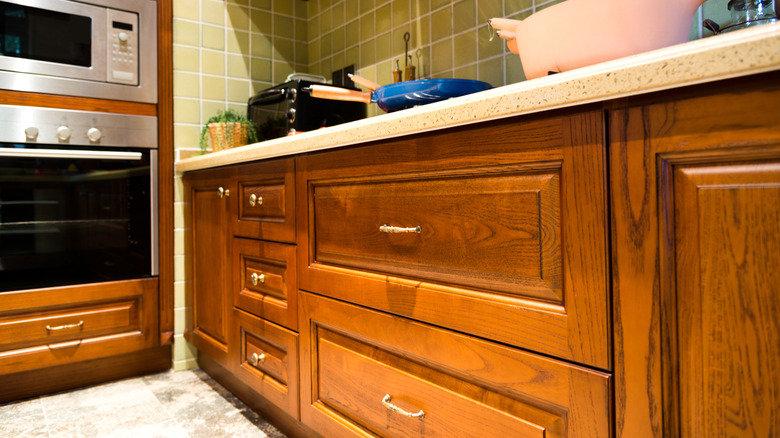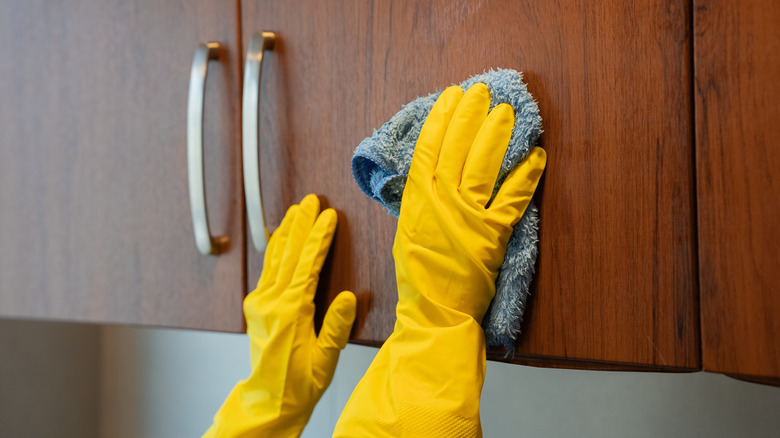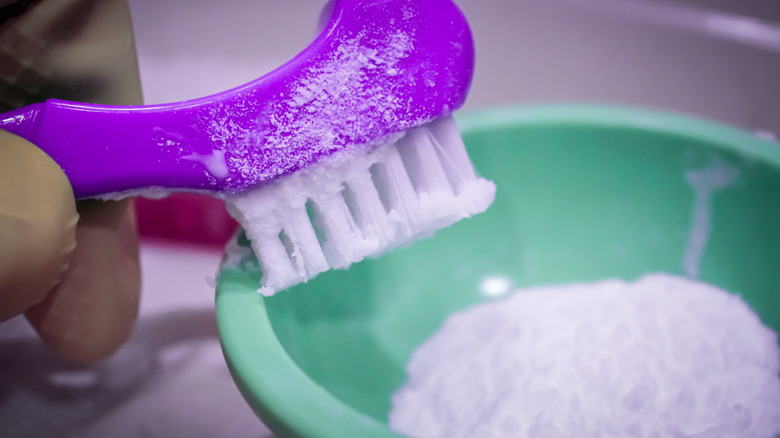How To Clean Grease Off Wood Cabinets Without Causing Damage To Your Finish
We may receive a commission on purchases made from links.
If you find yourself constantly battling a sticky, dull film on your kitchen cabinets, you're not alone. That grease buildup is what naturally happens when cooking in a kitchen. Tiny oil particles vaporize when you use the stovetop, settling on nearby surfaces and mixing with dust to form stubborn grime. The challenge is getting rid of that sticky mess without damaging the finish on your wooden cabinets. The best way to clean grease off wood cabinets without causing damage is by using a mild dish soap mixed with warm water and a microfiber cloth. The mixture works because dish soap is designed to break down grease and oil, but it's also gentle. It won't eat away at the cabinet finish.
Some people might think that stronger cleaning solutions or abrasive scrubbing pads work better, but they can damage wood cabinets. Harsh products like bleach, ammonia, or alcohol-based cleaners degrade the finish over time, potentially causing discoloration, dryness, and permanent damage. Once the protective finish is gone, the wood fibers becomes vulnerable to moisture, staining, and grease absorption. The way to preserve the finish is to use a gentle approach for regular cleaning. Leave anything stronger for older, stubborn spots. Cleaning your kitchen cabinets often enough can also help prevent that sticky layer of grease and dust from hardening into something that requires more drastic measures.
The best method for cleaning grease from wood cabinets
The easiest method for cleaning wood cabinets involves materials you probably already have on hand: dish soap, warm water, a microfiber cloth, and a clean towel. This process works well for routine cleaning and for removing light to moderate grease spots before they harden and attract more dust. Before you tackle all of your kitchen cabinets, pick an inconspicuous spot on one cabinet, like the inside of a door or near the floor, to test your cleaning solution. Testing makes sure the finish will survive being wiped down with the soap solution.
Follow these steps carefully to avoid making mistakes when deep cleaning your kitchen cabinets. First, mix a few drops of mild dish soap into a bowl or spray bottle filled with warm water. Stir or shake until it's slightly sudsy. Next, spray a microfiber cloth with the solution or dip it into it. Wring out the cloth so it's barely damp. Don't soak the cabinets with the cleaner or you risk the wood warping or the finish peeling. Gently wipe the surface of each cabinet, paying special attention to the areas around handles and near the stovetop and oven. If you notice lingering grease, clean the cabinets again with vinegar and warm water in equal parts. Once the grease is gone, remove any soapy residue by rinsing everything with a clean cloth soaked in fresh water. Dry your cabinets with a clean towel.
Wood cabinet cleaning solutions for stubborn grease
Sometimes, years of cooking residue builds up into a sticky, gunky film that a dish soap solution won't remove. This layer can make wooden cabinets some of the hardest spots to get clean in the kitchen. Before resorting to using a stronger, potentially damaging cleaner, try mixing two parts baking soda and one part water into a thick paste. Baking soda is a natural degreaser. You can use it in paste form to spot-treat stubborn areas without overwhelming the all your cabinetry with abrasive cleaners or too much liquid. Apply the paste with a soft cloth or soft-bristled brush, scrub the spot or stain briefly, and let the solution sit in place for a few minutes. Wipe it away with a clean, damp cloth, and then dry the area completely.
Another option for removing grime from wooden kitchen cabinets while also conditioning the wood is using an oil-based product like Murphy's Oil Soap. This cleaner helps cut through kitchen grease and is considered safe for wood surfaces. For really tough buildup that just isn't coming off, no matter how hard you scrub it with baking soda, you might need something more potent. Consider using a light degreaser that's safe for wood, like Weiman Cabinet and Wood Cleaner, though always test it on a small, hidden spot first. Overall, it's best to start with the most mild cleaner possible and move onto stronger cleaners only if absolutely necessary.


